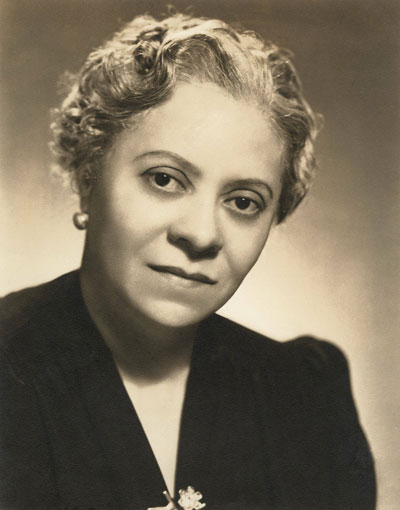Florence Price

Born: April 9, 1888, Little Rock, Arkansas
Died: June 3, 1953, Chicago, Illinois
Symphony No. 3 in C Minor
- Composed: 1938-39
- Premiere: November 6, 1940 by the Detroit Civic Orchestra, Valter Poole, conductor
- CSO Notable Performances: These are the CSO’s first performances of the complete work.
- Mvt. 3: Juba Dance was most recently performed in July 2024 at a Brady Block Party concert conducted by Kellen Gray.
- Mvt. 4: Finale was most recently performed in June 2023 at a Brady Block Party concert conducted by the 2022 MAC Music Innovator Antoine T. Clark.
- Instrumentation: 3 flutes, piccolo, 2 oboes, English horn, 2 clarinets, bass clarinet, 2 bassoons, 4 horns, 3 trumpets, 3 trombones, tuba, timpani, bass drum, castanets, chimes, crash cymbals, glockenspiel, sandpaper blocks, snare drum, suspended cymbals, tam-tam, tambour de Basque, triangle, whip, wood block, xylophone, harp, celeste, strings
- Duration: approx. 30 minutes
Florence Price was born in Little Rock, Arkansas. Her first music teacher was her mother, Florence Irene Smith. Her father, a dentist called Dr. James H. Smith, enthusiastically supported his daughter’s passion for classical music. With her parents’ blessing, Price studied at the New England Conservatory of Music, earning a double major in piano pedagogy and organ performance. She also entered the composition studio of the conservatory’s director, George Whitefield Chadwick, and while there wrote a symphony and string trio. Both works experimented with the African American folk sounds that she would later be known for.
After her studies, Price returned to the South. But family life and teaching took over. Large-scale composition temporarily fell by the wayside. She instead wrote smaller pieces, many of which were for her students. However, life in the Jim Crow South became intolerable as anti-Black racial violence increased. As a result, the Prices joined the mass exodus of African Americans from the rural south to the urban north—a move known as the Great Migration.
Price and her family arrived in Chicago in 1927. There, she found a vibrant network of Black classical musicians who supported her career. It was amid the dynamic period of the Black Chicago Renaissance—an era of social, cultural and political rebirth—that Price, the symphonist, emerged.
On July 15, 1933, the Chicago Symphony Orchestra premiered Price’s Symphony No. 1 in E Minor under conductor Frederick Stock. Price’s friend, a prominent Black civic leader and former concert artist named Maude Roberts George, had entered into a contract with Stock to ensure that this historic performance would come to fruition. George, who was at this time president of the National Association of Negro Musicians—the most influential organization of Black classical musicians in the United States—paid $250, around $5,000 in today’s money, to secure the performance, and Price’s Symphony No. 1 became the first work by an African American woman to be performed by a major national orchestra.
Price’s Symphony No. 1 catapulted her to stardom, causing her to devote more of her time to large-scale composition. Her Symphony No. 3 garnered further praise, even from First Lady Eleanor Roosevelt, who, in early November 1940, attended a rehearsal of Price’s latest work, performed by the Michigan WPA Symphony Orchestra of Detroit under conductor Valter Poole. “The orchestra rendered her symphony beautifully,” observed the First Lady of the two movements she heard. Enamored with Price’s symphonic voice, Roosevelt proclaimed that Price “has certainly made a contribution to our music.”
Although Price achieved a great deal of fame in the Midwest, an East Coast premiere proved elusive. It was Price’s dream to hear the Boston Symphony Orchestra perform her Third Symphony under conductor Serge Koussevitzky. She wrote to the conductor on several occasions, imploring him to put aside any prejudices he might have toward her race and gender. “My Dear Dr. Koussevitzky,” one letter began, “To begin with I have two handicaps—those of sex and race.” She then asserted, however, “I should like to be judged on merit alone.” Price closed with the polite request for him to examine her scores. Unfortunately, her letters remained unanswered. The Boston Symphony never performed Price’s music in her lifetime.
Still, these letters illuminate the inspiration behind the work and reveal more about this composer who was, for too long, silenced in the mainstream concert halls. Symphony No. 3, as Price explained to Koussevitzky, portrays “a cross section of present-day Negro life and thought.” Swelling, chromatic brass colors build a suspenseful opening, as if capturing the uncertainties of contemporary African American life, but a resolute melody based on Black folk idioms bursts through in the strings and a determined outlook ultimately prevails. The second movement is lyrical, languid and leisurely, and segues into a highly rhythmic Juba movement. The juba was a Black Antebellum-era plantation dance. Here, Price evokes the pentatonic (five-note) tunes of Black fiddlers and syncopated body patting rhythms that would accompany the dance. The final movement returns to the resolute overtones of the opening. Urgent, bold and folk-inflected, it is a powerful finale, cementing Price’s legacy as one of the most compelling composers of her time.
—Dr. Samantha Ege